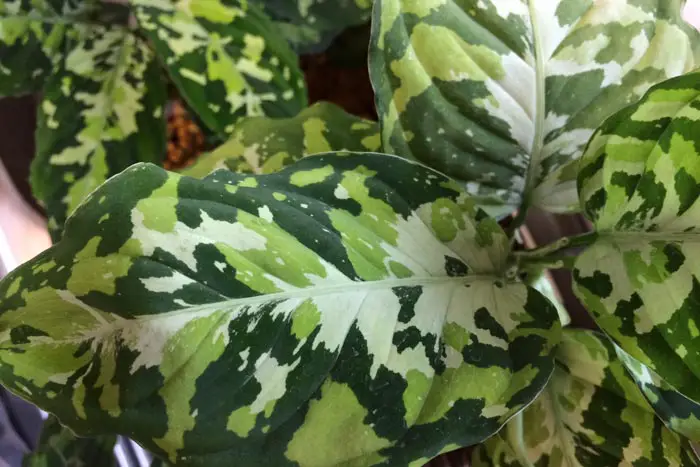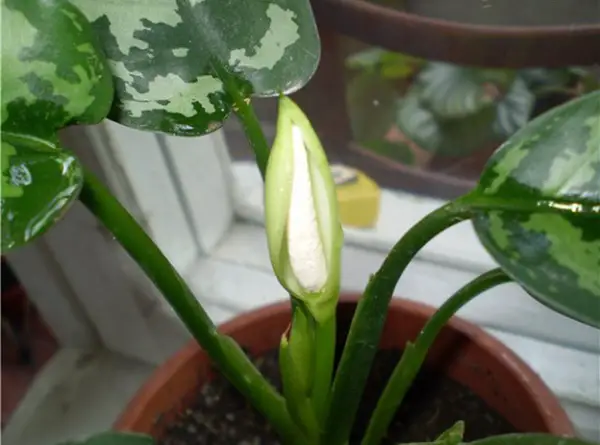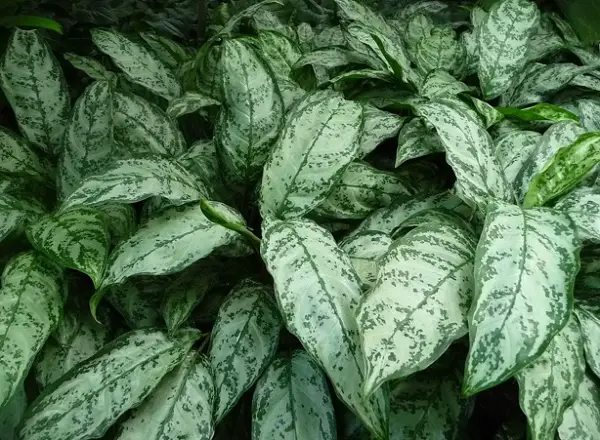Aglaonema pictum tricolor is well known and popular among lovers of decorative leafy indoor plants. Novice flower growers can take it for a young dieffenbachia rooted from an apical cuttings from a photo. But these are different cultures, although they belong to the same family. Aglaonema grows slowly. It is valued for its large, often different color painted leaves and easy care, but, unlike Dieffenbachia, it looks more graceful, has a short trunk.

What is Aglaonema pictum tricolor?
Aglaonema pictum tricolor comes from the humid tropics of Borneo and Sumatra. The compact plant does not exceed 60 cm in height. Many shoots radiate from the bottom of the main trunk. They are densely covered with green and bluish-green leaves.
The leaf blades are broadly oval, with wavy edges, reaching a length of 12–15 cm. From spots of light cream, gray or silver shades on the surface, a whimsical painting is formed, which gave the name to the species.
The modest white flowers of Aglaonema painted, like the red-yellow fruits, are simply lost against the background of the leaves. The plant easily adapts to existence in almost any room, does not mind being outdoors in the warm season. However, it categorically does not accept tobacco smoke and drafts.
Aglaonema pictum look like and structure
The rhizome of the aglaonema is compact, with a large number of thick, white-cream-like shoelaces. Depending on the species, the stems of the culture forms:
- vertical or creeping, rooting in nodes;
- juicy;
- with a round section;
- rather thick;
- with short smooth internodes;
- most cultivated species branch reluctantly, but some give lateral shoots from the base of the central shoot.
In indoor floriculture, aglaonema is valued for its leaves:
- they usually have the shape of an elongated ellipse, but can be broad-oval, cordate, linear;
- It has three color
- length – 10-15 cm, sometimes more;
- with a slightly pointed tip;
- smooth edge;
- the central vein is clearly expressed, depressed on the front, protrudes from the inside;
- petioles are long, vaginal;
- coloring – from plain green to painted with spots, borders, stripes or patterns of different colors and shades.
The height of the aglaonema usually does not exceed 70 cm. In this, it compares favorably with many ornamental-leafy plants with large plates.
Aglaonema pictum tricolor bloom and Flowering
At home, aglaonema rarely blooms. At the base of the bush, a not too long peduncle appears with a white ear and a greenish spoon-shaped or oval blanket surrounding it. Looks cute, but no more.

The female area of the cob is short and located at the base. The male gives pollen along its entire length.
If the flowering of the aglaonema is not of particular decorative value, then the berries are truly beautiful:
- fleshy;
- oval;
- ripe – bright red, yellow or white;
- each contains one large ellipsoidal seed;
- ripen 6-8 months after the plant stops blooming.
You can propagate the species aglaonema with your own seeds.
Is aglaonema poisonous?
The culture is toxic, like all members of the Aroid family, for example, anthurium, spathiphyllum, monstera. But to get poisoned, you need to eat a lot of leaves. A person is more likely to vomit than it will come to death.
But you need to work with the plant carefully, with gloves. Irritation of the mucous membranes is caused by the juice on the hands:
- when grafting;
- if the transplant of aglaonema is carried out inaccurately;
- during the removal of old vegetative organs;
- when the flower multiplies by dividing the bush.
Aglaonema pictum is poisonous to pets. Even worse, beautiful berries are of interest to children. So you need to think carefully, leave or immediately break off the flowering ear.
But the plant aglaonema benefits:
- moisturizes and purifies the air;
- releases phytoncides;
- adversely affects streptococcal bacteria;
- reduces the content of toluene, benzene.
Aglaonema pictum tricolor Care
A plant for beginners, with simple agricultural technology, easily fits into the interior of any apartment. But this does not mean that the flower can be left completely unattended or placed in Spartan conditions. Culture cannot stand:
- drafts;
- unlike most indoor plants – tobacco smoke;
- a variety of sprays and other means to give the leaves more shine;
- when a pot with a plant is exposed to the street or balcony.
Lighting and temperature
The flower can stand on the north window or in the back of the room, where little light enters. He does not like direct sunlight, burns may appear on the leaves.
The most comfortable temperature is 18-25 ° C. The lower limit cannot be lowered even in winter.
When caring for aglaonema at home, it should be borne in mind that species or varieties with white or silver leaves require more light and heat.
Aglaonema Watering
Proper watering is essential. From spring to early autumn, the ground should always be slightly damp, without stagnant water in the root area. At the end of the growing season, irrigation is reduced, but even short-term drying of the soil is not allowed. Watering is needed even, regular, but moderate.
The air humidity should be high. Leaves are often sprayed if the flower is near heating appliances – even in winter.
To make it easier for yourself, to prevent leaf rotting due to the water remaining on the vegetative organs in the cold season, you can put a wet terry towel on the battery. You just need to remember to wet it.
In summer, the flower needs to be watered periodically from the shower. In cool weather, wipe the leaves with a damp, clean cloth.
Feeding Aglaonema
During the active growing season, aglaonema is fed every 2-3 weeks. It is necessary to use preparations for decorative leafy crops. In autumn and winter, the flower is not fertilized.
After transplanting into ready-made, store-bought soil for aglaonema, the first feeding can be done no earlier than after 1.5-2 months. It takes so long for the nutrients added to the substrate by the manufacturer to deplete.
Aglaonema Potting and Transplanting
Only the first few years are replaced annually with a larger aglaonema pot. Mature plants should be replanted every 3-5 seasons. The operation is carried out in the second half of spring.
What is the best soil for aglaonema?
The soil for aglaonema needs a loose, fertile one. You can take a ready-made store-bought substrate, or transplant the plant into a mixture prepared on your own:
- leaf humus – 2 parts;
- peat – 1;
- coarse sand or perlite – 1;
- pieces of charcoal.
The pot should be taken with bottom holes, low or fill the “extra” volume with drainage. Expanded clay or broken red brick at the bottom must be mandatory – this not only protects the root from sticking during overflows, but also improves air access.
It is recommended to transplant aglaonema using the transshipment method:
- Remove the earthy clod from the pot.
- Pour drainage and a thin layer of fresh substrate onto the bottom of a slightly larger container.
- Place aglaonema in the center.
- Fill the free space with new soil.
- Know around the edges.
- Water abundantly.
Aglaonema Pruning and rejuvenation
A young plant does not need formation it gives a lush rosette of leaves located close to each other. But over time, the stem of the aglaonema still stretches out, although it grows slowly. Then the shoot is cut off, leaving a column 1-2 cm high. During the season, it will release one or more lateral shoots, overgrow with new leaves, and return attractiveness. The remaining stalk is allowed to propagate aglaonema.
To make the plant more bushy, you do not need to pinch the crown – there is a growing point that gives new leaves. And the internodes in the culture are already short.
potting tips for Aglaonema :
- keep the plant in a close pot with a good drainage layer;
- provide comfortable conditions;
- water regularly;
- feed during the growth period;
- spray the leaves frequently.
aglaonema propagation methods
There are many cultivation methods. But the simplest, vegetative, is difficult due to slow growth and the absence of lateral shoots. So growers who do not want to associate with seeds can get several new plants only from an adult aglaonema.
Cuttings
The operation is best performed in April-May. In the southern regions, it is impossible to wait until the heat comes – the processes take root worse.
Reproduction of aglaonema by cuttings, step by step:
- Cut off the elongated shoot of the old plant in mid-spring, leaving a column of 1-2 cm.
- Separate, if any, side branches.
- Cut into pieces of 8-10 cm. The most valuable cuttings are apical, from which beautiful young plants will quickly turn out.
- Sprinkle all wounds with activated charcoal powder.
- Dry in partial shade with free access of fresh air for 24 hours.
- Plant in calcined sand, deepening by half or a little more (4-6 cm).
- If there are leaves on the handle, lift them up, carefully tie them with a soft cord.
- Keep at high humidity, temperature 20-25 ° C. Sand should not dry out even for a short time.
- The roots will appear in about a month. Plant the aglaonema in small pots with a light substrate.
Many sources advise making cuttings of 4-5 cm. Of course, you will get more new plants, but with the same probability the pieces of the stem will disappear. Usually, experienced flower growers do not take risks, and still try to root the aglaonema by cutting cuttings of 8-10 cm.
grow aglaonema Pictum tricolor from seeds
This is not the easiest way to reproduce. Your seeds should ripen on the bush. They are freed from integumentary tissues, washed, planted to a depth of 1 cm in a peat-sand mixture (1: 1).
They are kept at a temperature of 22-25 ° C and high humidity under glass or transparent film. Daily:
- ventilate;
- remove condensation;
- check the humidity, if necessary, spray it from a household spray bottle.
When the shoots hatch, they gradually accustom the shoots to fresh air. After the appearance of two true leaves, they are seated in individual cups with a light substrate.
Full-fledged aglaonema with seed reproduction can be obtained in 3-4 years.
Dividing bush
When transplanting, the old plant is examined. If a root shoot has appeared that has at least 3-4 good leaves, carefully divide the bush into parts with a sharp knife.
Planted in smaller pots. For a week they are removed to a place that is less lit than before. Leaves are often sprayed.
It is useful to water the aglaonema baby after planting not with ordinary water, but with a solution of root or heteroauxin.
Why is my Aglaonema not growing?
Pests common for indoor plants may appear on aglaonema:
- thrips;
- spider mites;
- worms;
- scabbards;
- rarely, aphids or whiteflies.
Insecticides are used to combat, for example, Aktelik. If the owners want to use new odorless drugs, when fighting spider mites, you need to make sure that they have acaricidal action. This is not an insect, but an arachnid.
Of the diseases, rot is the most dangerous:
- root when growing aglaonema in dense soil, without drainage or bottom holes in the pot;
- leaves arising from the transfer of fungus from other plants, or spraying at low temperatures.
They get rid of infections of the aerial part by treatment with appropriate fungicides. If the root begins to rot, you will have to root the top.
Other problems:
- leaves curl cold;
- the plates are wrinkled – dry air;
- the tips are brown – the same;
- whitish spots on the leaves – sunburn;
- dark marks on the plates are the result of waterlogging of the soil;
- the bush turned black – hypothermia.
other aglaonema varieties and types
As a houseplant, aglaonema has been cultivated for less than a hundred years, but for breeders, this is quite a long time. It would seem that there should be many varieties, but this is not so. There are several cultivars, mostly based on Aglaonema commutatum.
This is probably due to the fact that:
- natural species are very decorative and varied;
- the flower grows slowly;
- only an old bush can stretch out.

Aglaonema marantifolium
Aglaonema marantifolium, synonym A.oblongifolium, type representative of the genus. This means that when solving all controversial issues, they are guided precisely by the description of this type of aglaonema.
Grows in Singapore, the Philippines, the island of Borneo. The stem is short, the leaves are elongated, with a sharp tip, about 30 cm. On a dark green background, there is a silvery-gray pattern of wide oblique stripes occupying most of the plates. Petioles up to 20 cm.
Aglaonema nitidum (Painted Drop Tongue)
Aglaonema nitidum is a species that eventually gives a central shoot up to 1 m. Lives in Malaysia, Thailand, Sumatra.
The leaves are dark or herbaceous green, usually monochromatic. The plates are relatively narrow, almost linear, up to 45 cm long. The species got its name because of the glossy sheen of the front of the leaves.
Aglaonema Nithidum produces white berries.
Aglaonema commutatum (Chinese evergreen)
Aglaonema commutatum eventually forms an erect stem from 20 cm to one and a half meters. Grows in the Philippines.
Leaves are elongated-elliptical or lanceolate, 20-30 cm with a width of 5-10 cm. The natural appearance is painted with an ash pattern. The berries are red.
Aglaonema Variable gave the most varieties, the most popular:
- Silver Queen with leaves of the corresponding color;
- Silver King – plates are covered with slanting wide stripes on a dark green background;
- Warburg – grayish filaments run along the lateral veins;
- Elegans – with olive markings and broad leaves;
- Treiba – ash spots are located in the center of the plate;
- Maria – grows up to 30-40 cm, emerald pattern on a dark background.
Aglaonema modestum
Aglaonema modestum is an aglaonema native to Indochina, found in the Malay archipelago. The trunk of an old plant reaches 50 cm and branches. Leaves up to 20 cm with a width of 6 cm, monochromatic, with clear lateral veins.
Aglaonema Moderate – the most shade-tolerant.
Aglaonema costatum (spotted evergreen)
Aglaonema costatum is a scenic species with very dark green leaves adorned with a wide white stripe along the central vein. Small strokes and dots of the same color are randomly scattered on the sides. The length and width of the plates are 20 and 10 cm, respectively.
The area is limited to the southwest of Malaysia.
Aglaonema roebelenii (Aglaonema crispum)
Aglaonema roebelenii is a spectacular species with oval leaves up to 30 cm. In the center of the plate there is a wide grayish-white area, cutting into dark green edges with feathers.
Aglaonema rotundum
Aglaonema rotundum is a type of aglaonema with broad cordate leaves. The main background is a very dark green, with bright mauve lines running along the central and lateral veins. The ear is the same color, the sail is somewhat lighter.
aglaonema brevispathum hospitum
Aglaonema brevispathum produces few leaves. The plates are long, with a white stripe in the center.
Aglaonema treubii
Aglaonema treubii quickly produces an upright stem and branches. Leaf plates with a grayish-olive pattern, length up to 17 cm.
Aglaonema Traby is considered to be the easiest to care for.
Aglaonema simplex
Aglaonema simplex grows no more than 35 cm. The leaves are monochromatic, dark green, 17 and 7 cm long, wide. The flowers are pretty, with a salad blanket.
Aglaonema care is simple, there are many unpretentious species and several picturesque varieties in the culture. The main thing is to remember that the plant loves warmth and moisture, does not tolerate direct sunlight or drafts.